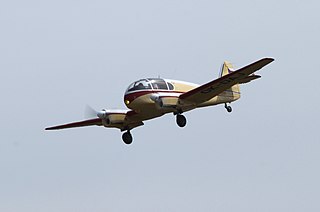
The Aero 45 was a twin-piston engined civil utility aircraft produced in Czechoslovakia after World War II. Aero Vodochody produced the aircraft in 1947–1951, after which the Let Kunovice rolled out these planes until 1961. In 1958 the Ae-45S became the first Czechoslovak plane to cross the Atlantic Ocean. It was the first product of the nation's postwar aviation industry and proved a great success, with many of the 590 produced being exported.
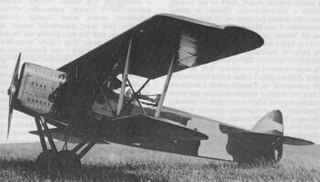
The Aero A.11 was a biplane light bomber and reconnaissance aircraft built in Czechoslovakia between the First and Second World Wars. It formed the basis for many other Czechoslovakian military aircraft of the inter-war period. Around 250 were built, with some remaining in service at the outbreak of World War II.

The Aero A.12 was a Czechoslovakian biplane light bomber and military reconnaissance aircraft manufactured in small numbers shortly after World War I. Although reminiscent of the Hansa-Brandenburg-designed aircraft that Aero was building during the war under licence as the Ae.10, the A.12 was the company's own design. It is perhaps most significant as the direct descendant of the highly successful A.11 and its various derivatives. An example of the type is preserved at the Letecké Muzeum in Kbely.
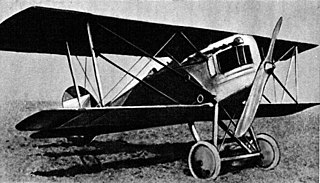
The Aero A.18 was a biplane fighter aircraft built in Czechoslovakia in the 1920s. It was a development of the Ae 02 and Ae 04 fighters Aero had designed during World War I, but also borrowed from the more recent A.11 reconnaissance-bomber design.
The Aero A.26 was a Czechoslovakian military reconnaissance biplane aircraft built by Aero Vodochody in the 1920s. It was Aero's last design to be based on the Hansa-Brandenburg B.I aircraft that the company had been building under licence during World War I as the Ae.10.

The Aero A.100 was a biplane light bomber and reconnaissance aircraft built in Czechoslovakia during the 1930s. It was the final step in a design lineage that extended back to the Aero A.11 a decade earlier. A.100s remained in service throughout World War II and for a few years postwar.
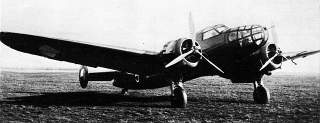
The Aero A.300 was a Czechoslovak bomber aircraft that first flew in 1938 as a much refined development of the A.304.

The Aero Ae 02 was the first fighter aircraft to be designed and built in Oshowitz. The Aero aircraft first flew in 1920.
The Aero Ae 04 was a Czechoslovakian biplane fighter aircraft of 1921. A development of the Ae 02, it was no more successful than its predecessor in attracting purchase orders, and it flew only in prototype form. Undaunted by the lack of interest, development continued as the A.18.

The Hansa-Brandenburg B.I was an unarmed military trainer and reconnaissance biplane of World War I, flown by the Austro-Hungarian Air Service. Early models were known internally to the Hansa-Brandenburg firm as the type D, while later models with a more powerful engine were designated FD. This aircraft was one of the earliest designs of Ernst Heinkel, who was working for Hansa-Brandenburg at the time. It was an entirely conventional two-bay biplane with staggered wings of unequal span. The pilot and observer sat in tandem in a long open cockpit.
The Aero Ae 50 was a prototype propeller-driven military reconnaissance aircraft built in Czechoslovakia.

The Aero Ae270 Spirit was a single-engine turboprop general utility aircraft that was developed by the Czech aircraft company Aero Vodochody. A prototype made its maiden flight in 2000, with European Aviation Safety Agency (EASA) Type Certification in 2005 and Federal Aviation Administration (FAA) type certification in 2006. No production followed.

The Curtiss XP-71 was a 1941 American proposal for an exceptionally large heavy fighter design. It was intended to serve as an extreme-range interceptor and escort fighter. While significant progress was made in the design phase, no prototypes were ever built, and the design was abandoned in 1943.

The Curtiss F7C Seahawk was a carrier-capable biplane fighter aircraft of the United States Navy Marine Corps in the late 1920s and early 1930s.

The I.Ae. 22 DL was an Argentine advanced training aircraft designed by the Instituto Aerotecnico in 1943, with a wooden structure, which resembled the North American NA-16.
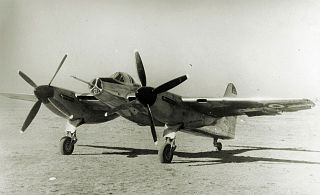
The I.Ae. 30 "Ñancú" was an Argentine twin piston engined fighter designed by the Instituto Aerotécnico in the late 1940s, similar to the de Havilland Hornet, but made of metal rather than wood. Only one prototype was completed; the project was abandoned in favour of a jet aircraft.
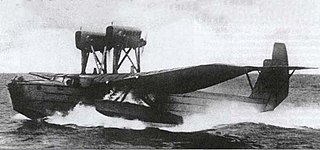
The ANT-8 was an experimental flying boat designed by Tupolev. It was designated the "MDR-2" by the military.

The FMA AeMB.2 Bombi was a bomber aircraft developed in Argentina in the mid-1930s. It was a low-wing cantilever monoplane of conventional configuration. It was fitted with fixed tailwheel undercarriage, the main units of which were covered by long, "trouser"-style fairings. The initial AeMB.1 configuration was fitted with a dorsal machine gun turret, later removed from the AeMB.2 to improve stability. Fifteen production examples saw service with the Argentine Air Force between 1936 and 1945. Two were lost to air accidents.

The AeroVironment Wasp III Small Unmanned Aircraft System is a miniature UAV developed for United States Air Force special operations to provide a small, light-weight vehicle to provide beyond-line-of-sight situation awareness. The aircraft is equipped with two on-board cameras to provide real-time intelligence to its operators. It is also equipped with GPS and an Inertial Navigation System enabling it to operate autonomously from takeoff to recovery. It was designed by AeroVironment Inc., and was first added to the Air Force inventory in 2007. There are two Wasp variants: the traditional version that lands on land, and a version that lands into the sea or fresh water. The Air Force accepted the Wasp AE in late May 2012, and the U.S. Marine Corps revealed in January 2013 that they had ordered the Wasp AE. The Wasp AE is designated as the RQ-12A.

The AeroVironment RQ-20 Puma is a small, battery powered, American, hand-launched unmanned aircraft system produced by AeroVironment based in California. Primary mission is surveillance and intelligence gathering using an electro-optical and infrared camera.
















